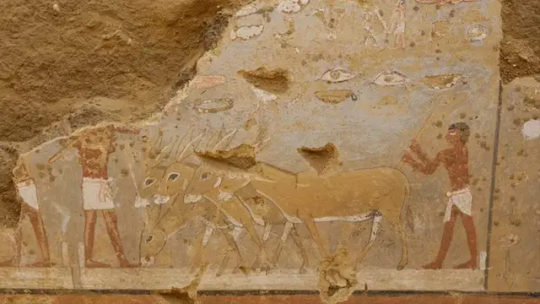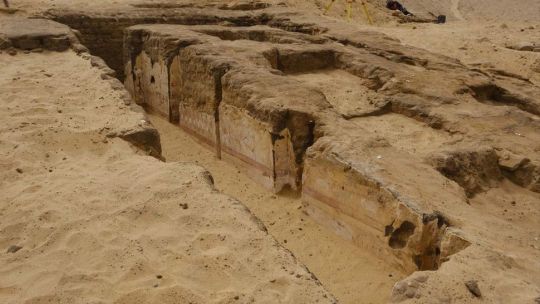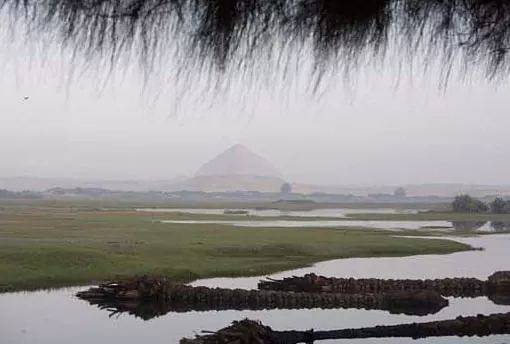#Dahshūr
Text

4,300-Year-Old Tomb of Palace Official Found in Egypt
A gentle wind blew the sand around the base of some pyramids in Egypt. The ancient structures dominated the landscape and likely drew attention away from an intricately decorated tomb nearby.
Not anymore.
Archaeologists were excavating an ancient cemetery at the Dahshūr archaeological site when they unearthed the long-forgotten tomb, Egypt’s Ministry of Tourism and Antiquities said in a March 21 Facebook post.
The 4,300-year-old tomb was built of mud bricks and partially buried in the sandy soil, archaeologists said and a photo shows.
The ancient grave was decorated with “wonderful inscriptions and scenes,” according to a news release from Egypt’s State Information Service.


Some inscriptions showed a glimpse of daily life such as people threshing grain, markets, ships sailing along the Nile River and offerings being presented, archaeologists said.
Photos show a few of these colorfully depicted scenes. In one scene, several people appear to herd a group of donkeys. Another shows several people in a procession carrying a bird and other objects, possibly offerings.
Based on the tomb’s inscriptions, archaeologists identified the its owner as a man named Seneb-Neb-Af and his wife, Idet, Egypt’s State Information Service reported. Seneb-Neb-Af was a palace official in charge of the “administration of tenants,” and Idet was the “Priestess of Hathor and Lady of the Sycamore.”
Archaeologists said the tomb dates to around 2300 B.C. or slightly earlier.
The Dahshūr archaeological site is in Dahshūr and about 25 miles south of Cairo. The area is part of the ancient Memphis UNESCO World Heritage Site, according to Britannica, and has five pyramids built between 2575 B.C. and 1756 B.C.
By Aspen Pflughoeft.

#4300-Year-Old Tomb of Palace Official Found in Egypt#Dahshūr#ancient tomb#ancient grave#ancient artifacts#archeology#archeolgst#history#history news#ancient history#ancient culture#ancient civilizations#ancient egypt#egyptian history#egyptian art
23 notes
·
View notes
Text
Archaeologists Unearth Intricately Decorated 4,300-Year-Old Tomb Of Palace Official In Egypt
Knewz
BY SAMYARUP CHOWDHURY
March 23, 2024
Archaeologists have discovered a 4,300-year-old tomb belonging to a palace official and his wife at the Dahshūr archaeological site south of the Saqqara Necropolis in Egypt.
Knewz.com has learned that the tomb is intricately decorated with inscriptions and scenes from daily life in ancient Egypt.
Read more…

View On WordPress
1 note
·
View note
Text
Kabbalah Hotep

Tema: Kabbalah Hotep
Thomo: Kabbala, (Egipties: "om te lees") het ook Kabbala, Kabbala, Kabbala, Kabbala of Kabbala gespel, soos dit in die tussen eu de en volgende eeue verskyn het. Middelryk vertaling uit die Egiptiese,
KA: hier
b' : sit terug
Sit dit daar
la la : my geheue my
HO: Ek het: ingeteken
Tee: vir die nageslag
p': soos hierdie.
Die eerste historiese dokument in die wêreld.
Daar is reeds in die 1ste dinastie begin om koninklike grafte daar te bou, wat replikas in Abydos het: óf die een óf die ander is dus senotafîs, maar die feit moet in elk geval beklemtoon word dat die geboue van S. groter in verhouding is, selfs as hulle dieselfde konstruksietegniek aanneem in rou bakstene met nisse in serie op die mure, bekend uit Naqādah (sien My persoon is in hierdie afstand geplaas) as tipies van die begrafnisargitektuur van die oorsprong. Een van hierdie grafte (reeds toegeskryf aan Hemaka, "he ma ka" moeder woon hier nou "nou na koning Udimu" hy wat bo ons almal vader bo woon") het meubels verskaf van seldsame belang vir die geskiedenis van kuns argaïek. Die argaïese burgerlike nekropolis bied 'n paar interessante oplossings van die mastaba (sien Moeder van julle vrees ons het eerbied): die graf van Hesy-Rē῾ (III dinastie "Afrikaans sê jy") is baie merkwaardig, waarin die oorspronklike eksterne kapel ontwikkel in 'n gang 11 nisse, wat elk 'n houtpaneel aan die onderkant het met 'n reliëfvoorstelling van die afgestorwene: van die eerste voorbeelde van daardie groot plat samestelling wat vaste stowwe en leemtes balanseer en wat in die Antieke Koninkryk sal ontwikkel. Die mees opvallende monument van S. dateer ook uit die III-dinastie: naamlik die trappiramide (sien piramide), die eerste eksperiment in klipkonstruksie van 'n monumentale gebou, en die eerste monumentale gebou self. Dit is 'n reeks van ses mastabas "amptelik ons moeders" bo-op mekaar, wat amper 'n kolossale trap na die hemel uitmaak (oorspronklike hoogte ongeveer 60m), wat 'n kompleks van ondergrondse gange bedek wat die begrafniswoonstel werklik uitmaak. Die kompleks van die buitegeboue van die graf, wat steeds verken word, het geen parallel in 'n latere tydperk nie: benewens 'n lykshuistempel van die soewerein, blyk dit al die toerusting te wees, wat in klip en op 'n groter as natuurlike skaal gereproduseer is. van kapelle, van kiosks, van trone, van altare wat nodig is vir die viering van die feeste van die koninklike jubileum. Sekerlik sodat die soewerein dit na sy dood vir ewig kan bly vier; maar dit is interessant dat elke detail van hierdie konstruksies nie net na ander konstruksietegnieke verwys nie (die klip boots houtstrukture na, die deure word in die mure uitgekerf, ensovoorts voorgestel), maar sluit ook 'n werklike moontlikheid van gebruik van die geboue uit (die kapelle het net die fasade, en die kamer, eerder as binne, is voor dit soos 'n klein binnehof wat deur mure beskerm word). Kortom, ons het te doen met 'n argitektuur wat nog nie by funksionele probleme betrokke is nie, wat meer moderne geboue as werklike geboue bou. Die onmiddellik volgende generasies heersers het hul voorkeure na ander dele van die Memfitiese nekropolis gebring (sien gīzah;"ek maak" abu roash" vuur"; abu meneer" diegene met die naam Sir"; dahshūr" kweek lemoene; medum en maak musiek ) : maar ongeveer veertig private mastabas “hier versteek” uit die IV-dinastie wys hoe die nekropolis op daardie stadium geensins verlate was nie, en ten minste een heerser hiervan, Shepseskaf, “hawe van aankoms gerig op ? " hy het sy enkelvoudige graf op die suidelike rand van die kompleks gebou, die sogenaamde Mastabat " hulle arriveer ons is hier " Fira῾un " vir die hoofman wat daar moet wees " .
0 notes
Photo

Know this: you can start over each morning. 📍 Dahshur Pyramid. Giza. Egypt 🇪🇬 #iregipto#egyptpassion #giza #dahshur (at Ahrāmāt Dahshūr) https://www.instagram.com/p/BoyyXW8hz9J/?utm_source=ig_tumblr_share&igshid=1oa20y6eeq2wt
56 notes
·
View notes
Text
Egypt Opens Its ‘Bent Pyramid’ For the First Time in More Than 50 Years
https://sciencespies.com/history/egypt-opens-its-bent-pyramid-for-the-first-time-in-more-than-50-years/
Egypt Opens Its ‘Bent Pyramid’ For the First Time in More Than 50 Years
At the necropolis of Dahshūr, an ancient Egyptian burial site on the west bank of the Nile, stands an odd-looking pyramid dating back some 4,600 years. Known as the “Bent Pyramid” because it boasts a peculiar double slope, the structure represents a pivotal moment in Egypt’s architectural history, when the ancients were transitioning to the straight-sided pyramids that are iconic today.
The Bent Pyramid has not been accessible to the public since 1965, as Live Science’s Laura Geggel reports. During the intervening decades, the 331-foot-tall structure underwent much-needed restoration work; experts fixed up internal and external stairs, added a lighting network and repaired stone work in the corridors and chambers. Thanks to their efforts, tourists can now enter a raised entrance on the newly reopened pyramid’s northern side, climb down an 86-yard tunnel and explore two chambers, according to Reuters’ Aidan Lewis.
Sneferu, a pharaoh who ruled over Egypt in the 25th century B.C., commissioned the pyramid, which was the first to be built at Dahshūr. It appears “bent” because its slope changes at the mid-way point; the lower part of the pyramid was built at an angle of 54 degrees, but the top part clocks in at an angle of 43 degrees. Mostafa Waziri, secretary general of Egypt’s Supreme Council of Antiquities, tells Lewis that the architectural direction shifted because cracks began to appear in the structure, indicating that it was unstable.
The Bent Pyramid may represent one step in Sneferu’s journey to find the perfect pyramid formula. Salima Ikram, an Egyptologist with the American University in Cairo, tells Robyn Bresnahan for the CBC that the pharaoh had four pyramids built on his behalf; while it’s not entirely clear why, experts think he “might have … been trying to get it right,” Ikram says.
The first was constructed at the site of Meidum, and it was originally a stepped pyramid—but, according to Encyclopedia Britannica, Sneferu later ordered that the structure be modified to form a “true,” or smooth-sided pyramid. The Meidum pyramid, however, “had [a] really acute angle and didn’t work out so well,” Ikram explains. Next, Sneferu turned his attention to the Bent Pyramid at Dahshūr, which represented the first attempt to build a true pyramid from scratch, but which also ran into problems. According to Ikram, Sneferu subsequently built a third, smaller pyramid, with his efforts finally culminating in the Red Pyramid at Dahshūr—a red limestone structure with smooth sides and a 43-degree angle.
This pyramid, Ikram says, “was perfect.”
Experts don’t know where Sneferu was ultimately buried. “Maybe in this [Bent] pyramid, who knows?” says Mohamed Shiha, director of the Dahshur site, per Lewis.
In addition to opening the Bent Pyramid, Egyptian officials have also re-opened an adjoining, 59-foot “side pyramid,” which may have been built for Sneferu’s main wife, Hetepheres. Khaled al-Anani, Egypt’s Minister of Antiquities, also announced that archaeological work near the Dahshūr pyramids had unearthed masks, tools and coffins, some of which contained well-preserved mummies.
Egypt has been working hard to promote its wealth of archaeological heritage in recent years, part of an effort to boost tourism to the country, which dipped after the 2011 uprising.
“[T]hey’re opening up new sites that have never been opened properly for tourists before,” Ikram tells Bresnahan. “Apart from a few archeologists, no one’s really been in there for the past 80 to 90 years. So it really is quite something.”
Like this article?
SIGN UP for our newsletter
#History
0 notes
Photo

he Bent Pyramid was probably the first planned from the outset to be a true pyramid, with smooth sides. This represents a glorious period in the evolution of the pyramid, comparable to that when Djsoer's architect, Imhotep, built the Step Pyramid at Saqqara. The Bent Pyramid was probably either the first or second of Snefru's pyramids, depending on who built the Medium Pyramid. It was almost certainly built prior to his other project at Dahshur, the Red Pyramid. The pyramid is also sometimes called the Rhomboidal, False, or Blunt Pyramid. The ancient Egyptians called it "Snefru Shines - South (pyramid)"... #egyptpassion #iregipto #egypt #dahshur #pyramids (at Ahrāmāt Dahshūr) https://www.instagram.com/p/Bo4HUD-Bq0i/?utm_source=ig_tumblr_share&igshid=1vo2x90cnklh1
19 notes
·
View notes